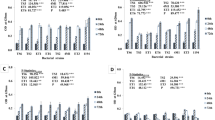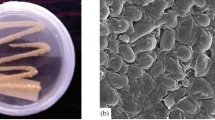Abstract
Recent studies show that ethyl glucuronide (EtG) can be decomposed by bacteria; whilst so far no degradation of ethyl sulphate (EtS) has been observed. In the present study, in vitro experiments with bacterial colonies were performed. Bacteria (Escherichia coli, Klebsiella pneumoniae, Clostridium sordellii) were isolated from autopsy material (liver, heart blood, urine, ascites, pericardial fluid, pleural fluid) tested for β-glucuronidase activity, and three bacterial strains were added to nutrient-deficient medium containing EtG and/or EtS and incubated at 36 ± 1°C. Samples were taken after various intervals up to 11 days, and EtG and EtS were determined by electrospray ionisation tandem mass spectrometry (LC-ESI-MS/MS). EtG was degraded by E. coli and C. sordellii—complete degradation occurred in the range of 3–4 days—and these bacteria exhibited β-glucuronidase activity. EtS was not affected within 11 days of incubation.


Similar content being viewed by others
References
Chang J, Kollman SE (1989) The effect of temperature on the formation of ethanol by Candida albicans in blood. J Forensic Sci 34:105–109
Corry JE (1978) A review. Possible sources of ethanol ante- and post-mortem: its relationship to the biochemistry and microbiology of decomposition. J Appl Bacteriol 44:1–56
Dresen S, Weinmann W, Wurst FM (2004) Forensic confirmatory analysis of ethyl sulfate—a new marker for alcohol consumption—by liquid-chromatography/electrospray ionization/tandem mass spectrometry. J Am Soc Mass Spectrom 15:1644–1648
Halter CC, Dresen S, Auwaerter V, Wurst FM, Weinmann W (2008) Kinetics in serum and urinary excretion of ethyl sulfate and ethyl glucuronide after medium dose ethanol intake. Int J Leg Med 122:123–128
Helander A, Dahl H (2005) Urinary tract infection: a risk factor for false-negative urinary ethyl glucuronide but not ethyl sulfate in the detection of recent alcohol consumption. Clin Chem 51:1728–1730
Helander A, Olsson I, Dahl H (2007) Postcollection synthesis of ethyl glucuronide by bacteria in urine may cause false identification of alcohol consumption. Clin Chem 53:1855–1857
Hoiseth G, Karinen R, Christophersen A, Johnsen L, Normann PT, Morland J (2006) Ethyl glucuronide in blood as a marker of ante-mortem ingestion of alcohol; possibility of false negative results. In: Zorec-Karlovsek M (ed) Programme and abstracts/The International Association of Forensic Toxicologists, 44th International Meeting, 26 August–1 September, Ljubljana, Slovenia, Medical Faculty, Ljubljana, pp 140–141
Hoiseth G (2007) A study of ethyl glucuronide in post-mortem blood as a marker of pre-mortem ingestion of alcohol. Forensic Sci Int 165:41–45
Hoiseth G, Kristoffersen L, Larssen B, Arnestad M, Hermansen NO, Morland J (2008) In vitro formation of ethanol in autopsy samples containing fluoride ions. Int J Leg Med 122:63–66
Hoppin JA, Ulmer R, Calafat AM, Barr DB, Baker SV, Meltzer HM, Ronningen KS (2006) Impact of urine preservation methods and duration of storage on measured levels of environmental contaminants. J Expo Sci Environ Epidemiol 16:39–48
Koneman EW, Minckler TM, Shires DB, De Jongh DS (1971) Postmortem bacteriology. II. Selection of cases for culture. Am J Clin Pathol 55:17–23
Koneman EW (2005) Koneman’s color atlas and textbook of diagnostic microbiology, 6th edn. Lippincott Williams & Wilkins, Philadelphia, PA
Lough PS, Fehn R (1993) Efficacy of 1% sodium fluoride as a preservative in urine samples containing glucose and Candida albicans. J Forensic Sci 38:266–271
Lum KT, Meers PD (1989) Boric acid converts urine into an effective bacteriostatic transport medium. J Infect 18:51–58
Peters JH, Nolen HW 3rd, Gordon GR (1982) Chlorhexidine gluconate as a urine preservative in analysis for oxalic acid. Clin Chem 28:1732
Robertson MD, Drummer OH (1995) Postmortem drug metabolism by bacteria. J Forensic Sci 40:382–386
Schloegl H, Dresen S, Spaczynski K, Stoertzel M, Wurst FM, Weinmann W (2006) Stability of ethyl glucuronide in urine, post-mortem tissue and blood samples. Int J Leg Med 120:83–88
Schloegl H, Rost T, Schmidt W, Wurst FM, Weinmann W (2006) Distribution of ethyl glucuronide in rib bone marrow, other tissues and body liquids as proof of alcohol consumption before death. Forensic Sci Int 156:213–218
Weinmann W, Schaefer P, Thierauf A, Schreiber A, Wurst FM (2004) Confirmatory analysis of ethylglucuronide in urine by liquid-chromatography/electrospray ionization/tandem mass spectrometry according to forensic guidelines. J Am Soc Mass Spectrom 15:188–193
Wurst FM, Skipper GE, Weinmann W (2003) Ethyl glucuronide—the direct ethanol metabolite on the threshold from science to routine use. Addiction 98(Suppl 2):51–61
Wurst FM, Yegles M, Alling C, Aradottir S, Dierkes J, Wiesbeck GA, Halter CC, Pragst F, Auwaerter V (2008) Measurement of direct ethanol metabolites in a case of a former driving under the influence (DUI) of alcohol offender, now claiming abstinence. Int J Leg Med 122(3):235–239
Author information
Authors and Affiliations
Corresponding author
Rights and permissions
About this article
Cite this article
Baranowski, S., Serr, A., Thierauf, A. et al. In vitro study of bacterial degradation of ethyl glucuronide and ethyl sulphate. Int J Legal Med 122, 389–393 (2008). https://doi.org/10.1007/s00414-008-0229-3
Received:
Accepted:
Published:
Issue Date:
DOI: https://doi.org/10.1007/s00414-008-0229-3




